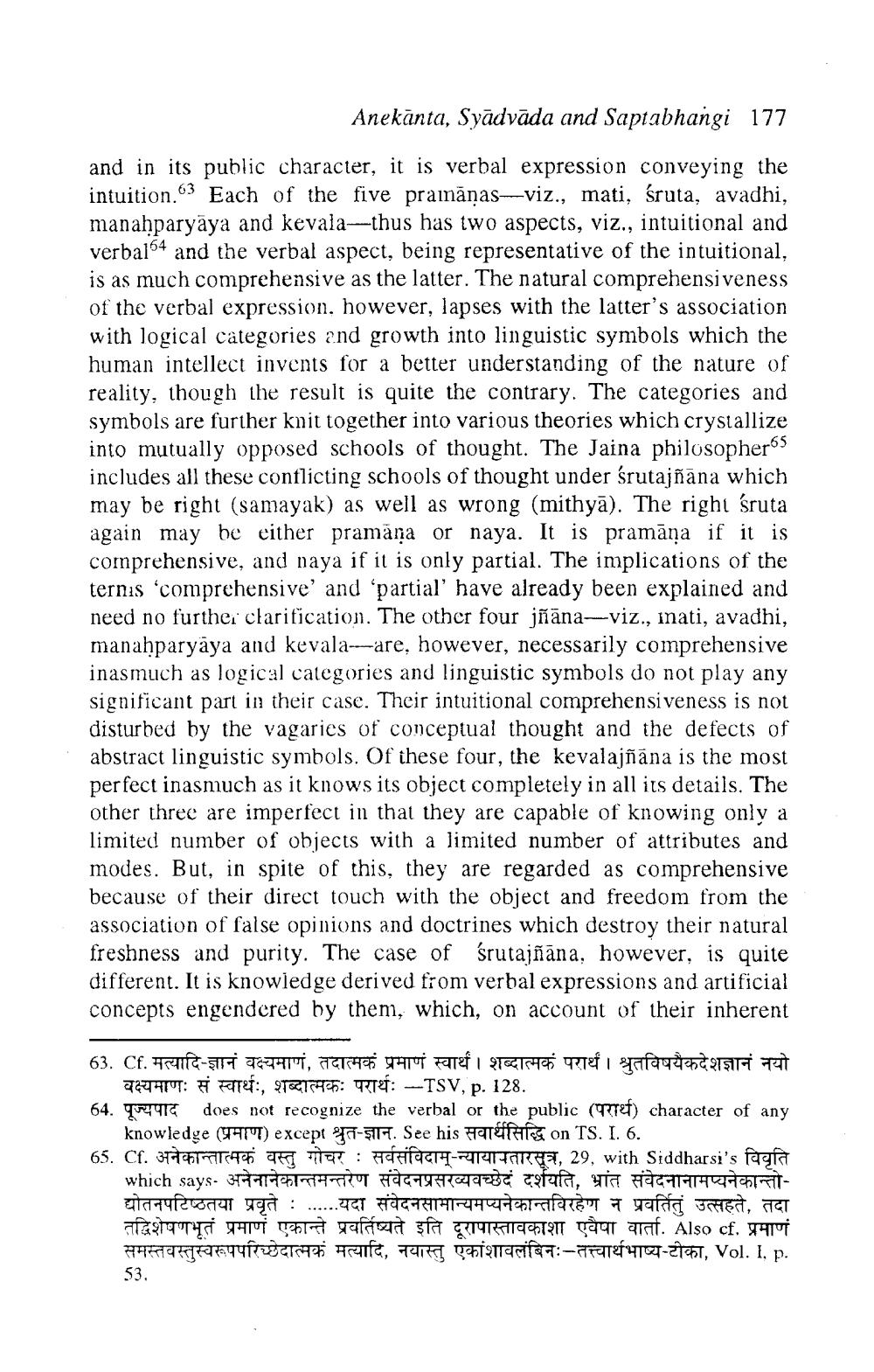________________
Anekanta, Syādvāda and Saptabhangi 177
and in its public character, it is verbal expression conveying the intuition.63 Each of the five pramānas-viz., mati, śruta, avadhi, manahparyāya and kevala--thus has two aspects, viz., intuitional and verbal54 and the verbal aspect, being representative of the intuitional, is as much comprehensive as the latter. The natural comprehensiveness of the verbal expression, however, lapses with the latter's association with logical categories and growth into linguistic symbols which the human intellect invents for a better understanding of the nature of reality, though the result is quite the contrary. The categories and symbols are further knit together into various theories which crystallize into mutually opposed schools of thought. The Jaina philosopheros includes all these conflicting schools of thought under śrutajñāna which may be right (samayak) as well as wrong (mithyā). The right sruta again may be either pramāņa or naya. It is pramāna if it is comprehensive, and naya if it is only partial. The implications of the ternis 'comprehensive' and 'partial' have already been explained and need no further clarification. The other four jñāna--viz., inati, avadhi, manahparyāya and kevala--are, however, necessarily comprehensive inasmuch as logical categories and linguistic symbols do not play any significant part in their case. Their intuitional comprehensiveness is not disturbed by the vagaries of conceptual thought and the defects of abstract linguistic symbols. Of these four, the kevalajñāna is the most perfect inasmuch as it knows its object completely in all its details. The other three are imperfect in that they are capable of knowing only a limited number of bjects with a limited number of attributes and modes. But, in spite of this, they are regarded as comprehensive because of their direct touch with the object and freedom from the association of false opinions and doctrines which destroy their natural freshness and purity. The case of śrutajñāna, however, is quite different. It is knowledge derived from verbal expressions and artificial concepts engendered by them, which, on account of their inherent
63. Cf. मत्यादि-ज्ञानं वक्ष्यमाणं, तदात्मकं प्रमाणं स्वार्थं । शब्दात्मकं परार्थं । श्रुतविषयैकदेशज्ञानं नयो
9747T: FITF:, 917: Ref: -TSV, p. 128. 64. पूज्यपाद does not recognize the verbal or the public (परार्थ) character of any
knowledge (प्रमाण) except श्रुत-ज्ञान. See his सवार्थसिद्धि on TS. I. 6. 65. Cf. 377mcach of : HHATH IT TORTFT, 29, with Siddharsi's fagfa
which says- अनेनानेकान्तमन्तरेण संवेदनप्रसरव्यवच्छेदं दर्शयति, भ्रांत संवेदनानामप्यनेकान्तोद्योतनपटिष्ठतया प्रवृते : ......यदा संवेदनसामान्यमप्यनेकान्तविरहेण न प्रवर्तितुं उत्सहते, तदा तद्विशेषणभूतं प्रमाणं एकान्ते प्रवर्तिष्यते इति दूरापास्तावकाशा एवैषा वार्ता. Also cf, प्रमाणं
ETTET TIETETY T Fifa, Felt Beatsiteria:-OTf47541-TCT, Vol. I, p.
53.




